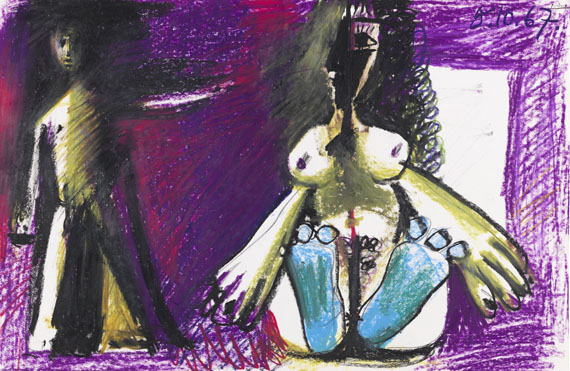Dictionary


Synthetic cubism
Synthetic Cubism followed Analytic Cubism as of 1912 and remained effective up into the 1920s, even though Cubism had already had its heyday around 1915.
There are fundamental differences between Synthetic Cubism and the formally related Analytic Cubism, while the early period had a focus on the analysis of the object and the fragmentation of its form into multiple views, it was now about the "synthetic" construction of an object from single geometric forms. Analytic Cubism performed the step from the concrete to the abstract - whereas Synthetic Cubism did it vice versa.
Overlapping color fields, a typical feature of Synthetic Cubism, are clearly contoured and treated less picturesque than in Analytic Cubism. Colorfulness also returns to the pictures and becomes an effective stylistic device. The additive basic principle of Synthetic Cubism puts this tendency at the side of Constructivism.
Once more, Pablo Picasso is the protagonist of Synthetic Cubism, another main figure worthwhile mentioning is Juan Gris (1887-1927), who had also affixed the theoretic principles of Synthetic Cubism in 1921.
The works of Synthetic Cubism are often quite plane and hint at spatiality only by means of darkened planes that suggest a hard shadow. Fernand Léger (1881-1955) had a more plastic concept of Synthetic Cubism, he developed a variant which composes the form from (again based on Cézanne) plastic volumes such as tubes, cylinders and cones.
Synthetic Cubism followed Analytic Cubism as of 1912 and remained effective up into the 1920s, even though Cubism had already had its heyday around 1915.
There are fundamental differences between Synthetic Cubism and the formally related Analytic Cubism, while the early period had a focus on the analysis of the object and the fragmentation of its form into multiple views, it was now about the "synthetic" construction of an object from single geometric forms. Analytic Cubism performed the step from the concrete to the abstract - whereas Synthetic Cubism did it vice versa.
Overlapping color fields, a typical feature of Synthetic Cubism, are clearly contoured and treated less picturesque than in Analytic Cubism. Colorfulness also returns to the pictures and becomes an effective stylistic device. The additive basic principle of Synthetic Cubism puts this tendency at the side of Constructivism.
Once more, Pablo Picasso is the protagonist of Synthetic Cubism, another main figure worthwhile mentioning is Juan Gris (1887-1927), who had also affixed the theoretic principles of Synthetic Cubism in 1921.
The works of Synthetic Cubism are often quite plane and hint at spatiality only by means of darkened planes that suggest a hard shadow. Fernand Léger (1881-1955) had a more plastic concept of Synthetic Cubism, he developed a variant which composes the form from (again based on Cézanne) plastic volumes such as tubes, cylinders and cones.
Offers
Headquarters
Joseph-Wild-Str. 18
81829 Munich
Phone: +49 89 55 244-0
Fax: +49 89 55 244-177
info@kettererkunst.de
Louisa von Saucken / Undine Schleifer
Holstenwall 5
20355 Hamburg
Phone: +49 40 37 49 61-0
Fax: +49 40 37 49 61-66
infohamburg@kettererkunst.de
Dr. Simone Wiechers / Nane Schlage
Fasanenstr. 70
10719 Berlin
Phone: +49 30 88 67 53-63
Fax: +49 30 88 67 56-43
infoberlin@kettererkunst.de
Cordula Lichtenberg
Gertrudenstraße 24-28
50667 Cologne
Phone: +49 221 510 908-15
infokoeln@kettererkunst.de
Hessen
Rhineland-Palatinate
Miriam Heß
Phone: +49 62 21 58 80-038
Fax: +49 62 21 58 80-595
infoheidelberg@kettererkunst.de
We will inform you in time.




